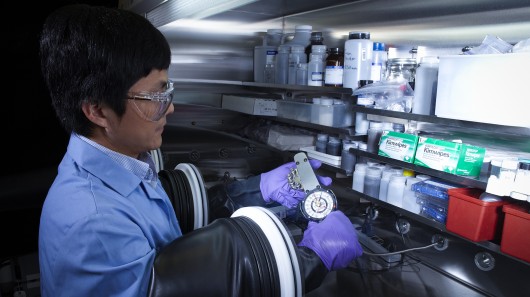
A new battery electrode designed at the Pacific Northwest National Laboratory (PNNL) combines liquid-state cesium and sodium to dramatically improve on the efficiency, safety and useful life of sodium-beta batteries (NBBs). If the technology is scaled up successfully, the advance could help build a smart electric grid that makes better use of renewables, such as solar and wind.
The amount of power from renewable sources keeps growing steadily every year, but to make full use of it grid infrastructure needs to be improved ahead of time. A big part of this is developing cheap, capable and flexible batteries that can store the intermittently-generated energy so it can be dispensed even when the Sun isn't shining and the wind isn't blowing.
Sodium-beta batteries, also known as Na-beta batteries or NBBs, are a good fit because they have high energy densities and a lot of flexibility in the size of their packs, ranging from a few kilowatt-hours to multiple megawatt-hours. They use a solid ceramic electrolyte membrane to transport sodium ions between a positive electrode (such as a metal-halogen compound) and a negative electrode (made of sodium). However, current NBBs must operate at temperatures of at least 350° C (660° F), and this poses challenges in terms of safety, cost and durability.
Now, material scientist Xiaochuan Lu and his colleagues at PNNL have created a new liquid electrode that addresses many of the current limitations of NBBs. Their cathode is a cesium-sodium alloy that allows the battery to operate at much lower temperatures, making them significantly more durable, safer, and easier to manufacture.
Sodium is a solid at standard temperature and pressure, but it has a very low melting point of only around 98° C (208° F). In NBBs, sodium is used in its liquid state as the negative electrode. Because the battery works by transporting sodium ions from one electrode to the other, the cell efficiency depends in great part on the contact area between the sodium and the ceramic electrolyte that separates the two electrodes.
The issue is that, at temperatures just above its melting point, sodium tends to form nearly spherical droplets that decrease the contact area with the electrolyte. To get around this, sodium must be heated all the way to 350° C, at which point it fully "wets" the ceramic electrolyte, maximizing contact area and battery efficiency. But forcing higher temperatures means wasting a great deal of energy, using expensive materials that must be able to deal with the heat (such as steel), and condemning the battery to a short life.
Lu and his colleagues set out to solve the problem by mixing the sodium with cesium, another soft metal with a very low melting point. In testing the alloy, they found that the new electrode material performs significantly better at lower temperatures, "wetting" the electrolyte at much lower temperatures than before.
Their prototype battery demonstrated a power capacity of 420 Ah/kg at 150° C (300° F), which matched the performance of the traditional design, though at much lower temperatures. In addition, their battery was also able to retain 97 percent of its storage capacity after 100 cycles, while a traditional NBB was only able to hold 70 percent of charge after 60 cycles.
Because the operating temperature is much lower, this opens the possibility of encasing the battery with polymers or other cheaper materials instead of steel. This would partially offset the higher costs of using the more expensive cesium in place of sodium, and it would also help streamline the manufacturing process.
The researchers are now scaling up the technology to test it for grid applications. If the results are positive, the advance could expand the use of NBB batteries well beyond today's estimated 300 MW of combined capacity between the US, Japan and Europe.

 Previous page
Previous page Back to top
Back to top







